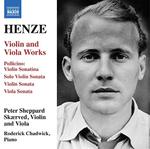|
Back
07/17/2018
“Violin and Viola Works”
Hans Werner Henze: Pollicino: Violin Sonatina – Solo Violin Sonata – Violin Sonata – Für Manfred – Peter Doll zum Abschied – Viola Sonata
Peter Sheppard Skærved (violin and viola), Roderick Chadwick (piano)
Recording: Parish Church of St. George, Harrow and Church of St. John the Baptist, Aldbury, United Kingdom (June 7 and 21 and July 18, 2016) – 68’41
Naxos 8.573886 – Booklet in English

   
Hans Werner Henze’s body of work represents his lifelong mission as an artist and activist. In liner notes of the Naxos collection “Violin and Viola Works” soloist Peter Skærved quotes a letter by Henze in 1980 to young artists in which makes the case that they “need to be the voice of the oppressed.” And, indeed, Henze was, as Skærved writes, “imbued with a lifelong sense of his obligation as an artist and a human being.”
Henze composed in many forms: from chamber, opera, German neoclassicism, so called ‘world music’ and such artistically stunning works as his Requiem, a defining jazz-classical fusion symphony which he dedicated to World War II (WWII) antifascist heroes of the resistance. His string and piano studies and chamber works are no less ambitious in expressions of the composer’s inner world and journey as a composer. Skærved observes, “I was always struck by his expectation that the broadest range of human emotion should be rendered as directly as possible.”
Henze started piano lessons in 1942 at age 16, but his training was interrupted by WWII. He was forced by his father to join the Nazi Youth, and he was eventually conscripted in 1944. Henze was a radio field operator, spending the last year of the war in a British Prisoner of War (POW) camp. In 1946 Henze resumed studies back in his destroyed home country, living in a bombed out flat with six other musicians.
The 1946 Violin Sonata, composed when Henze was 20, strikes as an intimate musical memoir. And in fact, Henze describes the piece as a work connected to six lost compositions he wrote during the war which he characterizes as ‘amateur’ sonatas. By age 21 he was studying with master composer Wolfgang Fortner. Later, Skærved reports that Henze had just written a piano reduction of a concerto by Fortner which influenced the Violin Sonata, but past that, it showcases a young composer with much to say. Henze was gay and left Germany in 1953 in protest of the country’s pervasive homophobia. He moved to Italy and traveled around the world, aligned to many humanitarian causes.
There is an atmosphere of improvisation, and sense of urgent expressive musical dialogue between Skærved and Chadwick: shifting counterpoint, agitated piano lines, and fiery, urgent violin responses. The sense of restlessness continues. Throughout, Chadwick’s chromatic phrasing captivates and Skærved’s technical artistry commands.
The recording opens with the Violin Sonatina (1979) which was ‘drawn’ from Henze’s children’s opera Pollicino which premiered a year later. Henze described the opera as a “box of children’s bricks” that tells stories through use of various instruments. In this case it is a narrative between violin and piano as a standalone piece. The violin in the Sonatina is meant to be the strident voice of ‘the Grandmother’...it conjures mercurial moods and mystery.
Skærved is the narrative fiddler of three characters in Solo Violin Sonata (1977, original version.) Based in part on characters from Latin literature – Tirsi, Mopso and Aristeo – Henze also conjured a scena of three lads the composer observed cavorting in Montepulciano while on vacation. The flighty fiddling, staccato voicings, rambling fiddling and note bending riffs showcase his vivid musical theatricality.
Two introspective miniatures are included: Für Manfred (1989, dedicated, in memoriam, for writer and television director Manfred Grater, champion of new music) and Peter Doll zum Abschied of 1999. Henze’s single movement, the Viola Sonata (1979), is a 20-minute viola-piano duet: dark, brooding moods, exploratory, technically bold and deeply expressive. Henze composed it with the specific artistry of Scottish viola virtuoso Garth Knox. The very warm viola tones give way to sharp interplay that is masterfully performed by Skærved and Chadwick.
Peter Sheppard Skærved and Roderick Chadwick are inside the chambers of Henze’s music. Several of the passages in the duets articulate Henze’s mastery of the separate, almost adversarial voicings of each instrument. There is an aura of improvisation as Henze contemplates themes of madness, despair and self-destruction. Expressions of personal crisis, a musical testament and witness to harrowing emotional reality. Indeed, Henze has much to communicate in his interpretations in sonata form.
Lewis J. Whittington
|